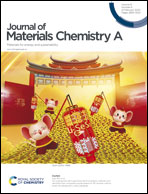Cation-exchange-assisted formation of NiS/SnS2 porous nanowalls with ultrahigh energy density for battery–supercapacitor hybrid devices†
Abstract
As a new type of electrochemical energy storage system, aqueous battery–supercapacitor hybrid (BSH) devices are attracting increasing interest due to their high energy and power density, high security, and low cost. Herein, hierarchical NiS/SnS2 heterogeneous nanowall arrays on carbon cloth (NiS/SnS2@CC) are synthesized via a simple cation-exchange method using SnS2@CC as the precursor. Benefiting from the maximum use ratio of the active materials and the synergistic effects between the SnS2 core and the NiS shell, NiS/SnS2@CC delivered an ultrahigh specific capacity of 430.38 mA h g−1 at a current density of 2.5 mA cm−2 (1.16 A g−1) with excellent rate capability of 185.08 mA h g−1 at a very high current density of 40 mA cm−2 (23.26 A g−1) and satisfactory cycling stability (82.6% of capacity retention after 1000 cycles). Moreover, all-solid-state BSH devices could be assembled using NiS/SnS2@CC as the battery-type cathode and Fe2O3/rGO@CC as the supercapacitor-type anode. With a maximum working voltage of 1.6 V, such a device exhibited a very high energy density of 104.23 W h kg−1 at a power density of 301 W kg−1 with excellent cycling stability and flexibility. This rational design and preparation strategy may provide new insight into the development of high-performance electrode materials for electrochemical devices.



 Please wait while we load your content...
Please wait while we load your content...